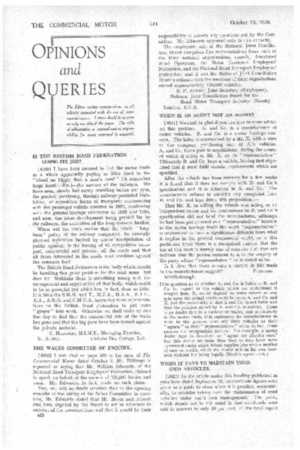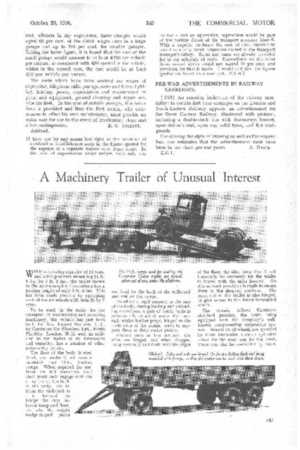OPINIONS
Page 56

Page 57

If you've noticed an error in this article please click here to report it so we can fix it.
and
QUERIES
The Editor invites correspondence on all subjects connected with the use of commercial motors. Letters should be written on only one side of the paper. The right of abbreviation is reserved and no responsibility for views expressed is accepted.
IS THE BRITISH ROAD FEDERATION DOING ITS JOB?
[4909] I have been amazed to find the motor trade as a whole apparently paying so little heed to the " cloud no bigger than a man's hand " (A somewhat large hand l—En.)—the menace of the railways. We have seen, slowly but surely unrolling before our eyes, the gradual paralysing, through railway promoted legislation, of opposition forms of transport; commencing with the passenger-vehicle operator in 1930, continuing with the general-haulage contractor in 1933 and 1934, and now, the latest development being pressed for by the railways, the extinction of the long-distance haulier.
When will the trade realize that the whole " longterm" policy of the railway companies, by carefully planned legislation backed by clever -manipulation of public opinion, is the forcing of all competitive transport, commercial and private, off the roads and that all those interested in the roads must combine against the common foe?
The British Road Federation is the body which should be handling this great problem for the road users—but does it? Methinks there is something wrong with the management and organization of that body, which ought to be so powerful but which has, in fact, done so little. It is time the S.M.M. and T., M.T.A., M.A.A., R.A.C., A.A., A.R.O. and C.M.U.A. instructed their representatives on the British Road Federation to put more " ginger " into work. Otherwise we shall wake up one fine day to find that the commercial side of the trade has gone and that the big guns have been turned against the private motorist.
C. HODGSON, M.I.M.T., Managing Director, St. Austell. Carlyon Bay Garage, Ltd.
THE WAGES COMMITTEE OF INQUIRY.
[4910] I note that on page 266 in the issue of The Commercial Motor dated October 9, Mr. Bibbings is reported as saying that Mr. William Edwards, of the National Road Transport Employers' Federation, claimed to speak on behalf of the owners of 120,000 lorries and vans. Mr. Edwards, in fact, made no such claim. You, sir, will no doubt recollect that in the opening remarks at the sitting of the Select Committee in question, Mr. Edwards stated that Mr. Bevin and. himself .had been deputed by the Board to act as witnesses in support of the memorandum and that it would be their B22
responsibility to answer any questions put, by the Committee. Mr. Edwards appeared only in this capacity.
The employers', side of the National joint Conciliation Board comprises five representatives from each ot the three national organizations, namely, Associated Road Operators, the Motor Transport Employers' Federation, and the National Road Transport Employers' Federation, and it was the National joint Conciliation Board's estimate that the members of these organizations owned approximately 120,000 vehicles.
R. P. BAILEY, joint Secretary (Employers), National Joint Conciliation Board for the Road Motor Transport Industry (Goods) London, E.C.3.
WHEN IS AN AGENT NOT AN AGENT?
[4911] We shall be glad if you call:give us some advice on this problem. A. and Co. is a manufacturer of motor vehicles. B. and Co. is a motor haulage concern. The latter is approached by a Mr. X. with a view to the company purchasing one of A. 'a vehicles.
A. and Co. takes part in negotiations, during the course of which it refers to Mr. X. as its "representative." Ultimately B. and Co. buys a vehicle, having first stipulated that it must fulfil certain requirements which are specified.
After the vehicle has been running for a few weeks it is found that it does not comply with B. and Co.'s specification and it is returned to A. and Co. The manufacturer refuses to consider any complaint from
B. and Co. and lays down this proposition:— That Mr. X. in selling the vehicle was acting as an independent trader and his concurrence in B. and Co.'s specification did not bind the manufacturer, although he had been put forward as a "representative," because in the motor haulage trade the word "representative" is understood to have a significance different from what it implies in the general commercial world, as in this particular trade there is a recognized custom that the use of this term is merely one of courtesy and does not indicate that the .person referred to is in the employ of the party whose " representative " he is stated to be.
Is it clear that there is such a custom in this trade
as the manufacturers. suggest? PUZZLED.
Middlesbrough. •
The question as to whether A. and Co. is liable to B. and Co. in respect of the vehicle which we understand it bought from X, would depend to some extent at any rate upon the actual relationship between A. and Co. and X, but the probability is that A and Co. is not liable and that the position stated by A. and Co. is correct. There is no doubt that in a number of trades, and particularly in the motor trade, it is customary for manufacturers to refer to the persons who sell their vehicles as their "
agents" or their" representatives "when, in fact, those persons are independent traders. For example, a motor dealer may be described as agent for Blank's cars," but this means no more than that he may have some agreement under which Blank supplies him with a number of cars on credit, which the dealer sells in his own business without his being legally Blank's agent.—En.]
WHEN IT PAYS TO MAINTAIN YOUR OWN VEHICLES.
[4912] In the article under this heading published in your issue dated September 25, approximate figures were given as a guide to show when it is possible, economically, to consider taking over the maintenance of road vehicles under one's own management. The point, which stands out in my mind is that overheads were said to amount to only 10 per cent, of the total repair cost, whereas in my experience, these charges would equal 60 per cent, of the direct wages costs in a large garage and up to 100 per cent, for smaller garages. Taking the latter figure, it is found that the cost of the small garage would amount to at least £120 per vehicle per annum, as compared with £80 quoted in the article, whilst in the second case, the cost would be at least £70 per vehicle per annum.
The costs which have been omitted are wages of supervisor, telephone calls, postage, rates and taxes, lighting, heating, power, depreciation and maintenance of plant and equipment, general cleaning and repair service for fleet. In the case of outside garages, this latter item is provided and thus the fleet owner, who commences to effect his own maintenance, must provide an extra unit for use in the event of involuntary stops and
other contingencies. R. G. TOLLETT. Ashtead.
II have not by any means lost sight of the incidence of .overhead or establishment costs in the figures quoted for the expense of a separate maintenance department. In the kind of organization under review, with only one mechanic and an apprentice, supervision would be part of the routine duties of the transport manager himself. With a capable mechanic the cost of that supervision would be a very small proportion indeed of the transport manager's salary. Rates and taxes are already provided for in my schedule of costs. Expenditure on the other items named above would not exceed 10 per cent. and provision for that is made. I would add that the figures quoted are based on actual fact.—S.T.R.1
PRE-WAR ADVERTISEMENTS IN RAILWAY CARRIAGES.
[40131 An amusing indication of the railway mentality; in certain first-class carriages on the London and North-Eastern Railway appears an advertisement for the Great Eastern Railway, illustrated with pictures, including a double-deck bus with downswept bonnet, open driver's seat, open top, solid tyres, and flat mudguards.
Considering the style of lettering as well as the veteran bus, one estimates that the advertisement must have
been in use since pre-war years, A. DAVIS. E.C.1.




























































































